During my recent trip to Vietnam, I had the opportunity to taste banh canh tom cua, a delicious noodle soup that is a popular dish in the country. This shrimp crab noodle soup was hearty, and flavorful, and left a lasting impression on me.
Intrigued, I decided to learn how to make it myself and discovered a world of unique ingredients, cooking techniques, and cultural significance behind this iconic dish.
I will share my personal experience of discovering the banh canh tom cua recipe and provide a comprehensive guide to making this flavorful soup at home.
What is banh canh tom cua?
Banh canh tom cua (also called “Banh canh cua”) is a Vietnamese noodle soup made with thick and chewy tapioca noodles, a savory broth made from pork bones and seafood, and garnished with succulent shrimp, crab meat, and scallions. Therefore it is also called Shrimp Crab thick noodle soup.
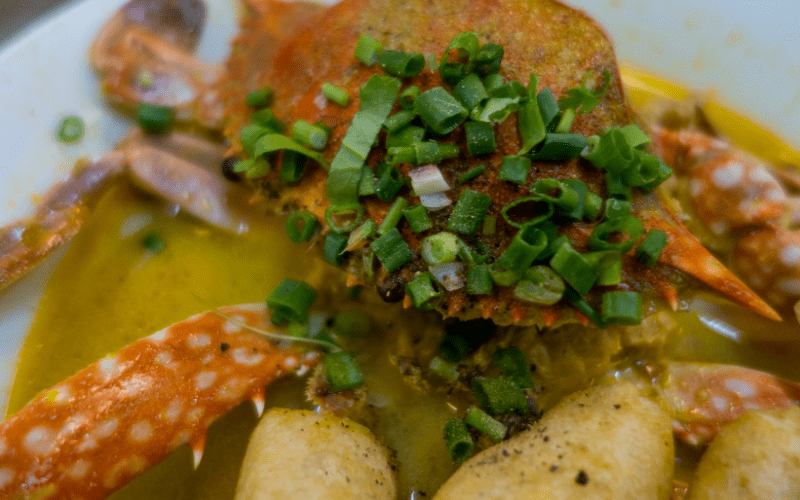
This dish is believed to have originated in central Vietnam and has become a staple of Vietnamese cuisine. Banh Canh Tom Cua is renowned for its unique texture, which is a result of the tapioca flour used in the noodles, and its distinct seafood flavor that is enhanced by a variety of herbs and spices.
It is a popular street food and can be found in many Vietnamese restaurants around the world.
What does banh canh tom cua taste like?
Banh canh tom cua has a rich and savory flavor that is dominated by seafood broth and succulent shrimp and crab meat. The tapioca noodles have a unique texture that is soft and chewy, which complements the soup’s overall consistency.
The dish is often seasoned with fish sauce, sugar, and other spices, which add a depth of flavor and complexity to the soup. The combination of the savory broth, the tender seafood, and the chewy noodles makes Banh Canh Tom Cua a truly satisfying and flavorful dish.
Banh canh tom cua recipe
Make sure to skim off any impurities that rise to the surface of the broth during cooking. Follow me, I guide Banh Canh Tom Cua recipe for you.
Cooking note
- Yield: 4–6 servings
- Prep Time: 30 minutes
- Cook Time: 2 hours
- Total Time: 2 hours 30 minutes
- Course: Main Dish
- Cuisine: Vietnamese
- Equipment:
- Large pot
- Colander
- Mixing bowl
- Rolling pin
- Cutting board
- Knife
Ingredients
- 1 lb tapioca flour
- 4 cups pork broth
- 1 lb. shrimp, peeled and deveined
- 1 lb. crab meat
- 1/4 cup fish sauce
- 1 tbsp. sugar
- 2 garlic cloves, minced
- 2 green onions, thinly sliced
- 1/4 cup cilantro, chopped
- 1 tsp. black pepper
- 1 tsp. vegetable oil
- Salt to taste
How to make banh canh tom cua?
Because this is a dish with many ingredients, I will guide you step by step to make it easy for you to follow as you make it.
How to make the noodles?
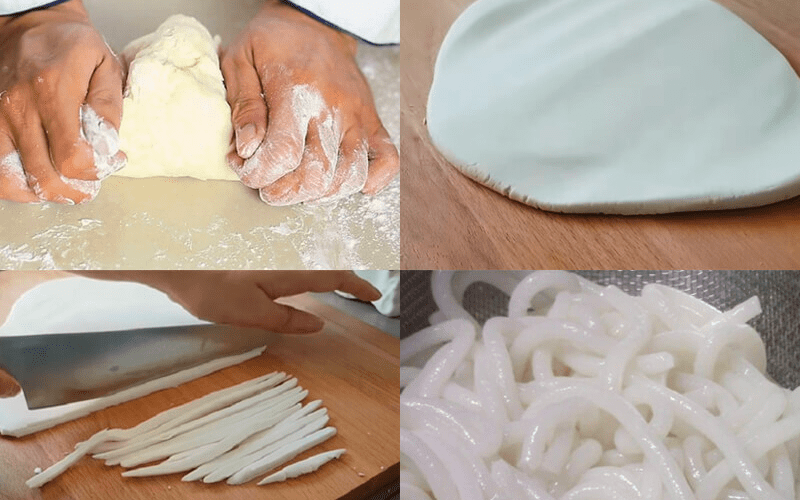
- In a mixing bowl, combine tapioca flour with 1 1/2 cups of water.
- Knead the mixture until it becomes smooth and pliable.
- Roll out the dough on a floured surface and cut into thin noodles.
- Boil the noodles in a pot of salted water until they float to the surface.
- Remove the noodles from the water and rinse with cold water.
How to prepare seafood?
- Peel and devein the shrimp.
- Shred the crab meat into small pieces.
- Set aside.
How to cook the soup of banh canh tom cua?
- In a large pot, heat vegetable oil over medium heat.
- Add minced garlic and cook until fragrant, about 1 minute.
- Add pork broth, fish sauce, sugar, and black pepper to the pot.
- Bring to a boil, then reduce heat to low and simmer for 1 hour.
- Add shrimp and crab meat to the pot and cook for an additional 10 minutes.
- Skim off any impurities that rise to the surface of the broth.
- Remove the pot from heat and set aside.
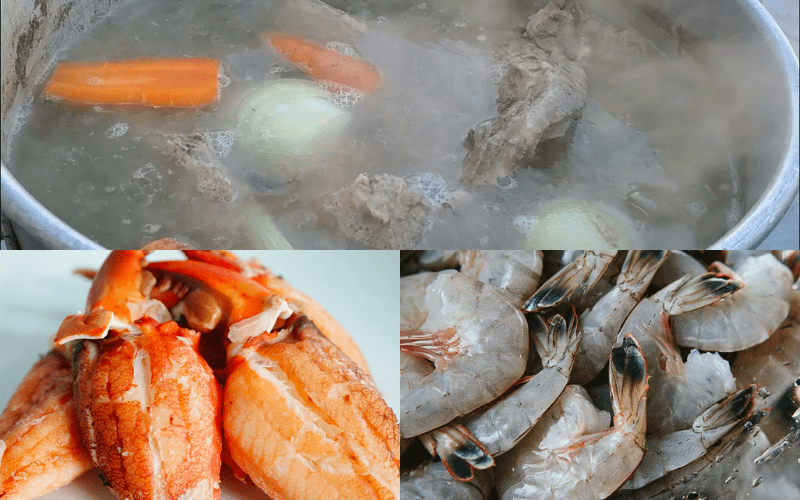
Read more: The Most Delicious Vietnamese Breakfast Foods To Try
How to arrange food of banh canh tom cua?
- Divide the noodles into serving bowls.
- Ladle the soup over the noodles, making sure to distribute the seafood evenly.
- Garnish with chopped green onions and cilantro.
- Serve hot with additional fish sauce and black pepper on the side.
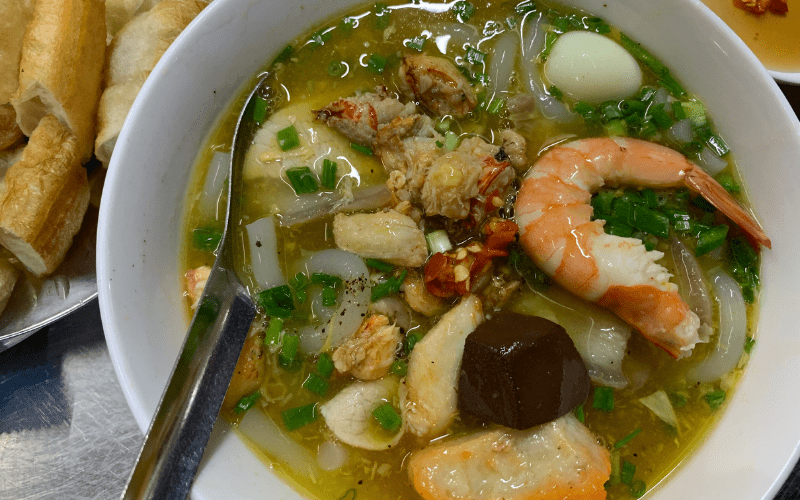
Table about nutrient facts of banh canh tom cua
Here is a table of the nutrient facts for Banh Canh Tom Cua:
| Nutrient | Amount Per Serving |
|---|---|
| Calories | 580 kcal |
| Total Fat | 12 g |
| Saturated Fat | 2.5 g |
| Cholesterol | 300 mg |
| Sodium | 2700 mg |
| Total Carbohydrate | 85 g |
| Dietary Fiber | 3 g |
| Sugars | 3 g |
| Protein | 38 g |
Note: Banh canh tom cua calorie count is an approximation and may vary depending on the specific recipe and serving size.
Substitute ingredients for cooking banh canh tom cua
Here are some substitute ingredients for cooking Banh Canh Tom Cua:
- Seafood: If you cannot find fresh shrimp or crab meat, you can use frozen seafood instead. Alternatively, you can use other types of seafood such as clams, mussels, or squid.
- Pork bones: If you do not eat pork, you can use chicken or beef bones instead to make the broth.
- Fish sauce: If you are allergic to fish or do not like the taste of fish sauce, you can use soy sauce or tamari instead.
- Sugar: If you do not want to use sugar, you can use honey or maple syrup instead to sweeten the broth.
- Noodles: If you cannot find fresh Banh Canh noodles, you can use dried Banh Canh noodles or other types of noodles such as udon or thick rice noodles. Alternatively, you may opt for Konjac Noodles as a healthier alternative.
- Vegetables: If you want to add more vegetables to the soup, you can use bok choy, spinach, or cabbage instead of bean sprouts.
Using these substitute ingredients, you can customize the recipe to your liking and still enjoy a delicious and authentic Banh Canh Tom Cua.
Read more: Chicken Glass Noodle Soup (Mien Ga)
Variations of banh canh tom cua
Banh Canh Tom Cua is a versatile dish that can be customized according to personal taste preferences and dietary restrictions. Here are some variations of the classic recipe:
- Banh Canh Tom Cua with Pork: Instead of seafood, you can use pork belly or pork ribs to make the broth and serve with sliced pork.
- Banh Canh Tom Cua Gio Heo is a variation of the classic recipe that includes sliced pork hock. The pork hock is simmered in the broth until tender and flavorful, adding a layer of texture and flavor to the dish. It is a popular variation in central Vietnam and is often served with crispy fried shallots and fresh herbs.
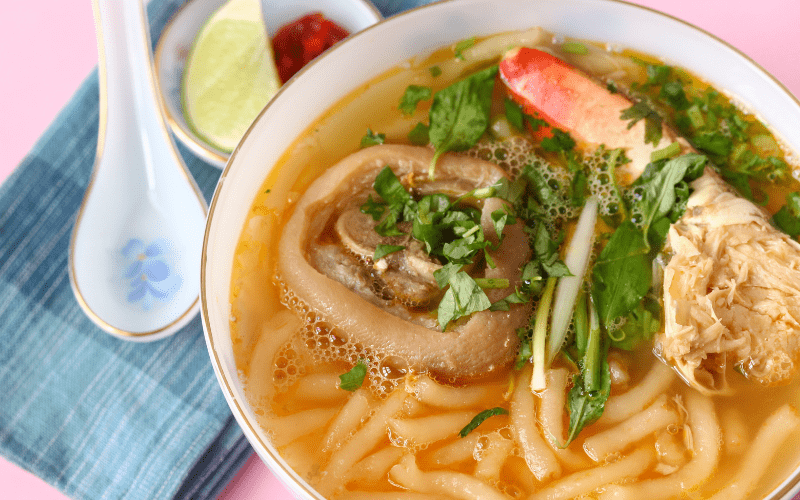
- Vegetarian Banh Canh Tom Cua: You can use vegetable broth and substitute the seafood with tofu or mushrooms.
- Regional Variations: Banh Canh Tom Cua can have regional variations in Vietnam. For example, in the southern region, it is common to use coconut milk in the broth to make it richer, while in the central region, the broth is more savory and served with crispy fried shallots.
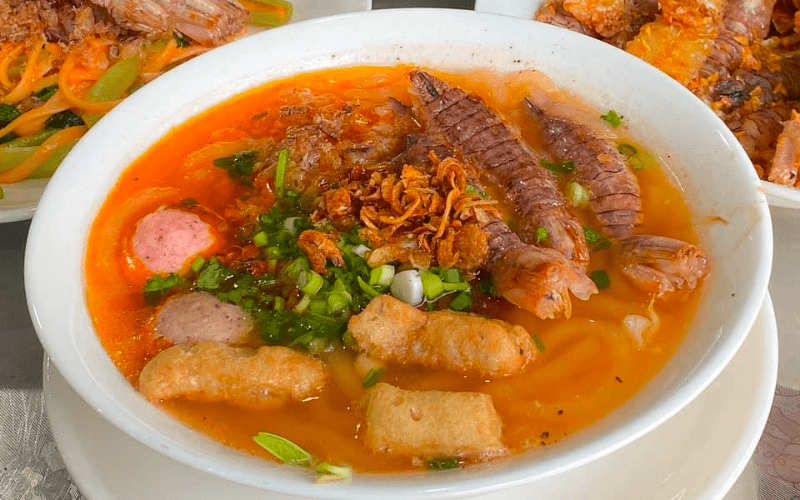
These variations offer a chance to experiment with the recipe and create unique and delicious versions of Banh Canh Tom Cua.
What to serve with banh canh tom cua?
Banh Canh Tom Cua can be served with a variety of accompaniments to enhance the flavors of the dish. Here are some suggestions:
- Lime wedges: The tangy flavor of lime can cut through the richness of the soup and add a refreshing taste.
- Chili oil: Chili oil can add heat and depth to the soup, making it more flavorful and satisfying.
- Fresh herbs: Cilantro, Thai basil, and mint can be chopped and added as a garnish to add freshness and aroma to the dish.
- Bean sprouts: Bean sprouts can be blanched and served on the side to add a crunchy texture and a nutty flavor.
- Hoisin sauce: Hoisin sauce can be used as a dipping sauce for the seafood, adding a sweet and savory flavor.
These accompaniments can be served alongside Banh Canh Tom Cua to create a balanced and satisfying meal.
Common mistakes when cooking banh canh tom cua
Here are some common mistakes to avoid when cooking Banh Canh Tom Cua:
- Overcooking the seafood: Overcooked shrimp and crab meat can become tough and rubbery, which can ruin the texture of the soup. Be careful not to overcook the seafood and remove it from the broth as soon as it is cooked through.
- Using too much water: Using too much water can dilute the flavor of the broth and make the soup less flavorful. Stick to the recommended amount of water in the recipe to ensure a rich and savory broth.
- Not skimming the broth: Skimming off the impurities that rise to the surface of the broth during cooking is important to ensure a clear and flavorful soup. Failing to skim off these impurities can make the soup cloudy and affect its taste.
- Using low-quality ingredients: Using low-quality seafood, broth, or noodles can affect the overall taste and quality of the dish. Use fresh, high-quality ingredients to ensure the best results.
- Overcrowding the pot: Overcrowding the pot with too many noodles or seafood can affect the cooking time and texture of the dish. Cook the noodles and seafood in batches if necessary to ensure they cook evenly and maintain their texture.
Tips and tricks to make banh canh tom cua
I will provide some expert advice on how to make perfect Banh Canh Tom Cua, create a flavorful broth, and cook the seafood to perfection. By following these tips and tricks, you can make a restaurant-quality Banh Canh Tom Cua that is sure to impress your friends and family.
Tips for perfect noodles
Knead the tapioca flour and water mixture until it is smooth and elastic.
Dust the dough with additional tapioca flour to prevent it from sticking.
Roll the dough thinly and cut it into small pieces to ensure even cooking.
Boil the noodles in salted water until they float to the surface.
Tricks for a flavorful broth
Use a combination of pork bones and seafood to create a rich and savory broth.
Roast the pork bones before simmering to enhance the flavor.
Add aromatics such as garlic, shallots, and ginger to the broth for additional depth of flavor.
Use high-quality fish sauce and sugar to season the broth to taste.
Advice for cooking the seafood
Do not overcook the shrimp and crab meat to avoid making them tough and rubbery.
Add the seafood to the broth towards the end of the cooking time to prevent overcooking.
Season the seafood with salt and pepper before adding it to the broth for additional flavor.
Use fresh, high-quality seafood for the best taste.
Read more : Exploring the Delicious Types of Pho
How to preserve banh canh tom cua?
Banh Canh Tom Cua is best enjoyed fresh and hot, but if you have leftovers, here are some tips on how to preserve it:
- Store in the refrigerator: Allow the soup to cool down to room temperature before storing it in an airtight container. Place it in the refrigerator and consume it within 1-2 days.
- Separate the noodles and broth: If you plan to store the soup for longer, it is recommended to separate the noodles and broth to prevent the noodles from becoming mushy. Store the noodles and broth in separate containers and reheat them together when ready to eat.
- Reheat properly: To reheat the soup, bring it to a boil on the stove over medium heat, stirring occasionally. Add additional water or broth if necessary to achieve the desired consistency.
Watch more in this video about how to make Vietnamese crab shrimp thick noodle soup to follow easily
FAQs
Is banh canh tom cua a spicy dish?
Banh Canh Tom Cua is not typically a spicy dish, but it can be made spicy by adding chili oil or fresh chili peppers. The dish is known for its rich and savory broth, chewy tapioca noodles, and succulent shrimp and crab meat.
However, spice levels can vary depending on personal taste and regional variations.
Can I freeze banh canh tom cua?
Yes, you can freeze Banh Canh Tom Cua. Allow the soup to cool down to room temperature before storing it in an airtight container. Freeze for up to 1 week. Thaw in the refrigerator before reheating.
Is banh canh tom cua a gluten-free dish?
Banh Canh Tom Cua can be a gluten-free dish if you use tapioca flour to make the noodles. Tapioca flour is made from cassava root and is naturally gluten-free. However, some brands of tapioca flour may contain trace amounts of gluten due to cross-contamination during processing.
If you have celiac disease or gluten intolerance, it is important to check the ingredients on the package to ensure that the tapioca flour is certified gluten-free.
Additionally, it is important to check the ingredients of any pre-made seasoning mixes or sauces to ensure that they do not contain any gluten-containing ingredients.
How do I make the soup thicker or thinner?
To make the soup thicker, you can simmer it for a longer period of time to allow the broth to reduce and become more concentrated. You can also add a slurry made of tapioca flour and water to the soup to thicken it.
To make the soup thinner, you can add more water or broth to the soup until you achieve the desired consistency.
Can I make banh canh tom cua in advance?
Yes, you can make Banh Canh Tom Cua in advance. However, it is best to store the noodles and broth separately to prevent the noodles from becoming mushy.
Store the noodles and broth in separate containers in the refrigerator for up to 2 days. When ready to serve, reheat the broth on the stove and add the cooked noodles and seafood. You may need to add additional water or broth to achieve the desired consistency.
How do I adjust the seasoning of the banh canh tom cua to my liking?
To adjust the seasoning of Banh Canh Tom Cua to your liking, taste the broth and adjust the seasoning as needed. If the broth is too salty, you can dilute it with additional water or broth.
If it is not salty enough, you can add more fish sauce. You can also add sugar or other seasonings such as soy sauce, garlic, or ginger to enhance the flavor. Remember to adjust the seasoning gradually and taste the broth frequently to ensure that you achieve the desired flavor.
Can I make banh canh tom cua with a seafood stock instead of a meat-based broth?
Yes, you can make Banh Canh Tom Cua with a seafood stock instead of a meat-based broth. This will result in a lighter and more delicate broth that allows the flavor of the seafood to shine through.
To make a seafood stock, simmer shrimp shells, crab shells, or other seafood scraps in water with aromatics such as garlic, shallots, and ginger for several hours. Strain the stock and use it as the base for the soup.
Note that a seafood stock may be less savory than a meat-based broth, so you may need to add additional seasoning to the soup.
Can I use a slow cooker to make banh canh tom cua?
While it is possible to use a slow cooker to make Banh Canh Tom Cua, it is not the traditional method of preparation. Banh Canh Tom Cua is typically made on the stove, with the broth simmering for several hours to extract maximum flavor from the bones and aromatics.
Can I use different types of broth for banh canh tom cua?
Yes, you can use different types of broth for Banh Canh Tom Cua, depending on your personal preferences and dietary restrictions.
If you are vegetarian or vegan, you can make a vegetable broth to use as the base for the soup. Simmer vegetables such as onions, carrots, celery, and mushrooms in water for several hours to create a flavorful and aromatic broth. You can also add miso paste or soy sauce to the broth to add a savory and salty flavor.
The type of broth you use will affect the flavor of the Banh Canh Tom Cua, so it is important to choose a broth that complements the other ingredients in the soup.
Keep reading: How to Make Hu Tieu Nam Vang Noodles at Home?
Conclusion
As you can see, Banh canh tom cua is a delicious and satisfying Vietnamese noodle soup that is loved by many. Whether you’re a seasoned cook or a beginner, this recipe can be customized to your personal taste preferences and dietary restrictions.
With the tips and tricks we have provided, you can make perfect noodles, create a flavorful broth, and cook the seafood to perfection. Additionally, we have provided some suggestions for accompaniments to enhance the flavors of the dish and some tips on how to preserve any leftovers. So go ahead and give this recipe a try, and enjoy the unique and delicious flavors of Banh Canh Tom Cua!